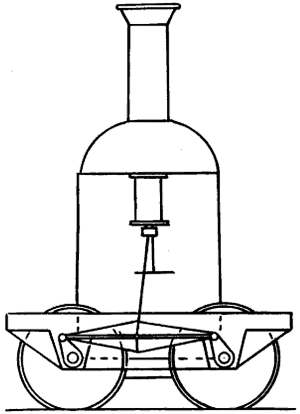Phineas Davis and the York Locomotive
From History of Baltimore City and County (1881)
 [p.322] An advertisement published by the company [Baltimore and Ohio
Railraoad] Jan. 4, 1831, offering a premium for two locomotives which
should come up to the specifications therein set forth, is somewhat
remarkable, for the reason that it shows a very thorough knowledge of
what a railroad engine ought to be, although the motor which the
president describes had not yet taken form and shape. The object of the
advertisement was to submit to the ingenious mechanics of the country
certain ascertained facts and principles, to the end that they might be
applied to the construction of an effective locomotive. Such was the
faith of the company in the utility of the inventions of Mr. Knight and
Mr. Winans that it was expressly stipulated they should be embodied in
the competing locomotives. The experience of fifty years has shown that
the company did not claim too much for these improvements. The sum of
four thousand dollars (the premium being included in the price) was to
be paid for the locomotive, constructed in accordance with these
specifications, which should be deemed the best after thirty days'
actual use, and three thousand five hundred dollars for the second
best. Three locomotives were constructed in pursuance of this
advertisement, and the tests to which they were subjected and the
exhibitions given of their working capacity constitute a most
interesting chapter in the history of the Baltimore and Ohio Railroad.
The company extended the time named in the advertisement for testing
the engines (June 1, 1831) to June 27th, and in point of fact the trial
did not come off till July 12th. Only two competitors put in an
appearance at the first trial, the “York,” manufactured by Davis &
Gartner, at York, Pa., and an engine from New York City, the name of
which is not recorded in the local chronicles. Another engine, built at
Gettysburg, Pa., by George Welsh, had been entered for the prize, but
it was not ready to take the track on the day finally set for the
contest. At this exhibition the “York” won all the honors. On the first
trip it made a mile in three minutes, drawing a car containing forty
persons, and rounded the curves without checking speed. Several trips
were made, and the engine ran a mile in two minutes and a half on some
portions of the road. After the Davis engine had astonished the
assembled multitude with its splendid performance, the New York engine
made a short trip, but it fell so far behind its competitor in the
essential quality of speed that not much notice was taken of its
merits, whatever they may have been. The “York” was kept on the road
until it was worn out; the builder, Phineas Davis, was made chief
constructor of engines for the company, and remained in its service
until he was accidentally killed while taking his employ�s on an
excursion to Washington, on Sept. 27, 1835. Four of [p.323] the engines
built
by Mr. Davis after the model of the “York” are still in daily use at
the Mount Clare depot as “ regulators” for making up trains and pushing
cars about from one yard to another.
[p.322] An advertisement published by the company [Baltimore and Ohio
Railraoad] Jan. 4, 1831, offering a premium for two locomotives which
should come up to the specifications therein set forth, is somewhat
remarkable, for the reason that it shows a very thorough knowledge of
what a railroad engine ought to be, although the motor which the
president describes had not yet taken form and shape. The object of the
advertisement was to submit to the ingenious mechanics of the country
certain ascertained facts and principles, to the end that they might be
applied to the construction of an effective locomotive. Such was the
faith of the company in the utility of the inventions of Mr. Knight and
Mr. Winans that it was expressly stipulated they should be embodied in
the competing locomotives. The experience of fifty years has shown that
the company did not claim too much for these improvements. The sum of
four thousand dollars (the premium being included in the price) was to
be paid for the locomotive, constructed in accordance with these
specifications, which should be deemed the best after thirty days'
actual use, and three thousand five hundred dollars for the second
best. Three locomotives were constructed in pursuance of this
advertisement, and the tests to which they were subjected and the
exhibitions given of their working capacity constitute a most
interesting chapter in the history of the Baltimore and Ohio Railroad.
The company extended the time named in the advertisement for testing
the engines (June 1, 1831) to June 27th, and in point of fact the trial
did not come off till July 12th. Only two competitors put in an
appearance at the first trial, the “York,” manufactured by Davis &
Gartner, at York, Pa., and an engine from New York City, the name of
which is not recorded in the local chronicles. Another engine, built at
Gettysburg, Pa., by George Welsh, had been entered for the prize, but
it was not ready to take the track on the day finally set for the
contest. At this exhibition the “York” won all the honors. On the first
trip it made a mile in three minutes, drawing a car containing forty
persons, and rounded the curves without checking speed. Several trips
were made, and the engine ran a mile in two minutes and a half on some
portions of the road. After the Davis engine had astonished the
assembled multitude with its splendid performance, the New York engine
made a short trip, but it fell so far behind its competitor in the
essential quality of speed that not much notice was taken of its
merits, whatever they may have been. The “York” was kept on the road
until it was worn out; the builder, Phineas Davis, was made chief
constructor of engines for the company, and remained in its service
until he was accidentally killed while taking his employ�s on an
excursion to Washington, on Sept. 27, 1835. Four of [p.323] the engines
built
by Mr. Davis after the model of the “York” are still in daily use at
the Mount Clare depot as “ regulators” for making up trains and pushing
cars about from one yard to another.
[p.322 footnote] Phineas Davis was a self-taught man, and like all eminent men of his class in science and art, he was capable of achieving the most decisive results. Mr. Davis was a native of New Hampshire, and early in life migrated to York, Pa., where he arrived poor, friendless, and unknown. He began the watch-making business in York with an estimable citizen, and soon met with great success. After continuing in business for several years he turned his attention to chemistry, but soon applied himself to steam and the construction of steam-engines, in which he look great delight. In connection with his partner, Mr. Gartner, he built several engines for various purposes, and made many improvements to illustrate their power and capacity for work. The first efficient locomotive engine used upon the Baltimore and Ohio Railroad was constructed by Davis A Gartner, under his direction, at York, and brought to Baltimore upon wagons. From this period up to the time of his death a large number of locomotives were built for this great work under his immediate superintendence, and scarcely any one ever succeeded another without evincing some improvement in design or execution. The construction of locomotives was particularly suited to his taste and capacity, and the Baltimore and Ohio Railroad Company very soon discovered his value in that department and offered him such facilities as induced him to leave the concern at York in the care of his partner and engage in making engines in Baltimore at the company's shops. He had been so engaged for a couple of years, and by his talents, industry, and perseverance, under the liberal encouragement of the company, he had by successive improvements brought the locomotive to a high degree of perfection. He was on a trial-trip with his latest-improved engine when he met his death. Upon the [p.323 footnote] return of the train from Washington he rode on the tender to watch the movements of the engine, and while thus engaged it ran off the track, which brought the cars in the rear with great force upon the tender, instantly killing its only occupant. His body was brought to Baltimore and interred in the Friends' burying-ground at the corner of Aisquith and Fayette Streets. He left two orphan children, his wife having died a short time before.
The first succcessful locomotive engine after the “York” on the Baltimore and Ohio Railroad was also built by Messrs. Davis & Gartner, and called the “Atlantic.” The experimental trial of this engine took place on Aug. 6, 1832, and was highly successful. It was the first engine that completely succeeded in burning anthracite coal. A trip of eighty miles per day was performed with a consumption of one ton of coal. From this time forward steam-power was generally used on the road.
 19
February - short
biography, births, deaths
and events on date
of the York locomotive's first trial.
19
February - short
biography, births, deaths
and events on date
of the York locomotive's first trial.





